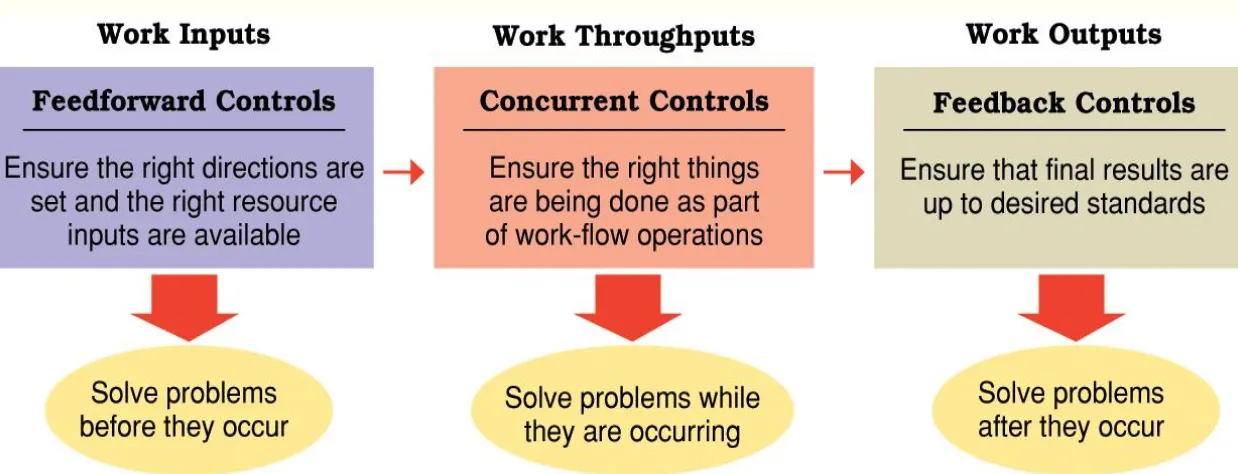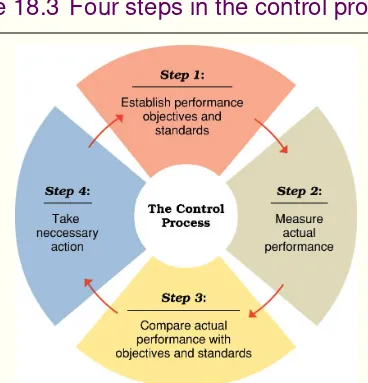Controlling
–
Processes and Systems
Planning Ahead
Why and how do managers control?
What are the steps in the control
process?
Study Question 1: Why and how do managers control?
Controlling
The process of measuring performance and taking action to ensure desired results.
Has a positive and necessary role in the management process.
Ensures that the right things happen, in the right way, at the right time.
Study Question 1: Why and how do managers control?
Feedforward controls
Employed before a work activity begins.
Ensures that:
Objectives are clear.
Study Question 1: Why and how do managers control?
Concurrent controls
Focus on what happens during work
process.
Monitor ongoing operations to make
sure they are being done according to
plan.
Study Question 1: Why and how do managers control?
Feedback controls
Take place after work is completed.
Focus on quality of end results.
Provide useful information for
Study Question 1: Why and how do managers control?
Internal and external control
Internal control
Allows motivated individuals and groups
to exercise self-discipline in fulfilling job expectations.
External control
Study Question 2: What are the steps in the control process?
Steps in the control process:
Step 1 — establish objectives and
standards.
Step 2 — measure actual performance.
Step 3 — compare results with objectives
and standards.
Study Question 2: What are the steps in the control process?
Step 1
—
establishing objectives
and standards
Output standards
Measure performance results in terms of
quantity, quality, cost, or time.
Input standards
Measure effort in terms of amount of work
Study Question 2: What are the steps in the control process?
Step 2 — measuring actual performance
Goal is accurate measurement of actual
performance results and/or performance efforts.
Must identify significant differences between
actual results and original plan.
Study Question 2: What are the
steps in the control process?
Step 3
—
comparing results with
objectives and standards
Need for action reflects the difference between desired performance and
actual performance
Comparison methods:
Study Question 2: What are the steps in the control process?
Step 4
—
taking corrective action
Taking action when a discrepancy exists between desired and actual performance.
Management by exception
Giving attention to situations showing the
greatest need for action.
Types of exceptions
Study Question 3: What are the common control systems and techniques?
Employee discipline systems
Discipline is the act of influencing
behavior through reprimand.
Discipline that is applied fairly,
consistently, and systematically
Study Question 3: What are the common control systems and techniques?
Employee discipline systems
Progressive discipline ties reprimands
to the severity and frequency of the
employee’s infractions.
Progressive discipline seeks to achieve
compliance with the least extreme
Study Question 3: What are the common control systems and techniques?
To be effective, reprimands should
Be immediate.
Be directed toward actions, not
personality.
Be consistently applied.
Be informative.
Occur in a supportive setting.
Study Question 3: What are the common control systems and techniques?
Important financial aspects of
organizational performance
Liquidity
The ability to generate cash to pay bills.
Leverage
The ability to earn more in returns than the cost
of debt.
Asset management
The ability to use resources efficiently and
operate at minimum cost.
Study Question 3: What are the common control systems and techniques?
Break-even analysis
Determination of the point at which
sales revenues are sufficient to cover costs.
Break-Even Point =
Fixed Costs / (Price – Variable Costs)
Used in evaluating:
New products
Study Question 3: What are the common control systems and techniques?
Purchasing control
A productivity tool
Trends in purchasing control:
Leveraging buying power
Committing to a small number of
suppliers
Study Question 3: What are the common control systems and techniques?
Inventory control
Goal is to ensure that inventory is just
the right size to meet performance needs, thus minimizing the cost.
Methods of inventory control:
Study Question 3: What are the common control systems and techniques?
Statistical quality control
Quality control involves checking
processes, materials, products, and
services to ensure that they meet high standards.
Statistical quality control involves:
Taking samples of work.
Controlling
Balance Sheet (EXAMPLE: Company X, December 2002)What company Owns
Controlling
Statement of Income and Retained EarningsControlling
Financial Ratios (EXAMPLE: Company X, 2002) Liquidity Ratios Current Ratio Current Assets Current Liabilities 1400000450000 = 3,11
Measure the ability to meet short-term obligations.
As minimum 2.0 is used but it varies. A current ratio of 10 shows
Controlling
Financial Ratios (EXAMPLE: Company X, 2002)Liquidity Ratios Acid Test Ratio
Current Assets-Inventory Current Liabilities
1400000-700000
450000 = 1,56
For quickly converting to cash we calculate this ratio.
Controlling
Financial Ratios (EXAMPLE: Company X, 2002) Leverage Ratios Debt-to-assets ratio Total Debt Total Assets 14500004400000 = 0,33
Relative importance of stockholders and
outside creditors as a
source of enterprise’s
capital.
Controlling
Financial Ratios (EXAMPLE: Company X, 2002)Activity Ratios Inventory Turnover Cost of Goods Sold
Inventory
2000000
Controlling
Financial Ratios (EXAMPLE: Company X, 2002)Activity Ratios Accounts Receivable
Turnover
Net Sales
Accounts Receivable
4000000
Controlling
Financial Ratios (EXAMPLE: Company X, 2002)Activity Ratios Asset Turnover
Net Sales Total Assets
4000000
Controlling
Financial Ratios (EXAMPLE: Company X, 2002)Profitability Ratios Profit Margin Net Income
Net Sales
1050000
Controlling
Financial Ratios (EXAMPLE: Company X, 2002)Profitability Ratios Return on Total Assets
Net Income Total Assets
1050000
Controlling
Budgets
Plans for the future allocation and use of resources over a fixed period of time.
Financial Budgets
Planning of cash for the coming period and how the company intends to use it.
Three Types of Financial Budgets
1.Cash Budgets: Estimate future revenues and
expenditure and their timing during budgeting period 2.Capital Expenditure Budgets: Describes future
Controlling
Budgets
Plans for the future allocation and use of resources over a fixed period of time.
There are responsibility centers in organizations.
Cost Center:
Primary financial concern is control of
costs
Revenue Center (Sales or Marketing):
The manager
has revenue targets to meet
Controlling
Budgeting Process
Budgets can be prepared by a central group and imposed on everyone by top management (top-down approach).
This does not take the advantage of information from lower management.
Alternatively, budgets can be prepared in responsibility centers.
They tend to be inflated and doesn’t consider upper
Controlling
Audits of Financial Data
Audits are investigations of an organization’s activities
to verify their correctness and identify any need for improvement.
External Audits: required at least once a year for publicly held organization by independent companies
Controlling
Non-financial Controls
Human Resource Control: Seen in Human Aspects of organizing
Management Audit: By answering some questions about management such as planning, organizing and
staffing, directing, control, resource planning and control


